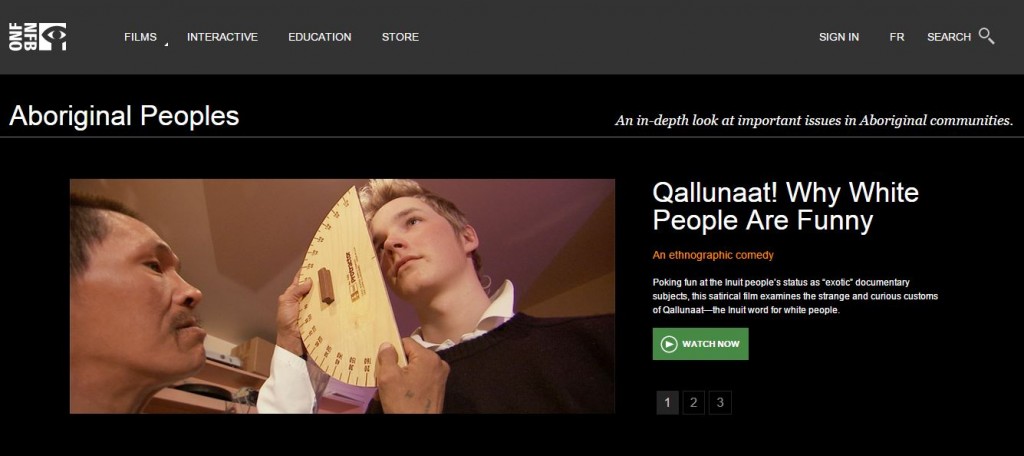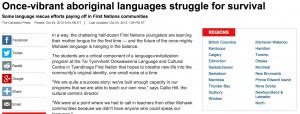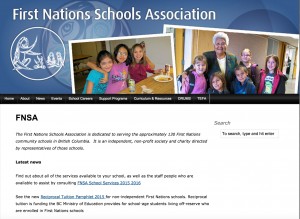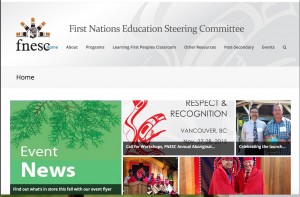By Canadian Broadcasting Corporation [Public domain], via Wikimedia Commons
Tag Archives: Media
Project of Heart Module 2.2
Recently released, the link is to an 40 page e-book which has resources/stories about the history of residential schools in British Columbia. There are videos, primary documents, and classroom activities. For those of you who like hardcopies, there is an internal email link to obtain your own recyclable paper copy. 🙂
Aboriginal Multi-Media Society
The Aboriginal Multi-Media Society “is an Aboriginal communications society dedicated to serving the needs of Aboriginal people throughout Canada (incorporated in 1983 under the Alberta Societies Act). The Aboriginal Multi-Media Society is an independent Aboriginal communications organization committed to facilitating the exchange of information reflecting Aboriginal culture to a growing and diverse audience. AMMSA is dedicated to providing objective, mature and balanced coverage of news, information and entertainment relevant to Aboriginal issues and peoples while maintaining profound respect for the values, principles and traditions of Aboriginal people”.
http://www.ammsa.com/content/history
There are links to native radio and Book Reviews. There is a list of links to native publications. http://www.ammsa.com/content/publications
Journey Immemorial Module 2.1
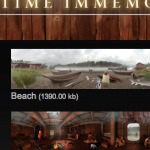 From http://www.sfu.museum/time/en/ 09 27 15
From http://www.sfu.museum/time/en/ 09 27 15
Wow! I did not know this website existed. Three dimensional room-scapes and space-scapes. Videos and interviews with First peoples. Now I just have to think how to share with staff so it doesn’t just become a check off box.

The Inuit Broadcasting Corporation
The web page of the Inuit Broadcasting Corporation offers information about its goals as “Nunavut’s public producer” of media, as well descriptions of its current programming. Inuit focused news stories are available as well as video clips from various segments. I was specifically interested in the kids section of site which links to latest issue of the Inuit comic “Super Shamou” and the interactive site of a kids show “Takuginai.ca”, which is offered in two aboriginal languages as well as english and french.
Module 1 – Post 1
Brendan Clark
National Film Board of Canada – Aboriginal Peoples Channel
The NFB has created an Aboriginal people’s channel which highlights 35 indigenous documentaries. The content on this channel provides an outlet for aboriginal-produced content which spans the storytelling spectrum. From a historical examination through the eyes of female aboriginal artists (Hands of History) to investigations of modern clashes between police and Indigenous people (You Are on Indian Land). These videos showcase perspectives, values and ideals of aboriginal people in Canada. Artists are invaluable in providing commentary to controversial issues and these artists lend their voices to many issues which are not known to the general population.
The only downfall to this website is the lack of a summary beneath each video. You do have to click into the pictorial representation to determine the nature of each. It would be beneficial to have these categorized in ways that would allow for faster assessment. For example, having an historical category and traditions section would allow the user to filter videos of interest.
Otherwise, this website (or channel of a website) provides a glimpse into the important issues in aboriginal culture.
To view this website: https://www.nfb.ca/channels/aboriginal_peoples_channel/
(Module 1 – Post 3)
The Endangered Languages
http://www.endangeredlanguages.com/
This site looks at endangered languages all over the world. The site is an excellent resource for gaining a perspective on the wide scope of the problem and the many languages that are on the verge of disappearing.
Resource links to scholarly publications and various types of research can be found at this site. There is an easy to use searchable database that can point to information related to education, anthropology, political issues and environmental factors.
One of the most useful parts of the site is the worldwide language map which indicates locations across the globe where languages are at risk or severely endangered of becoming extinct.
Once-vibrant aboriginal languages struggle for survival
http://www.cbc.ca/news/canada/once-vibrant-aboriginal-languages-struggle-for-survival-1.1173659
This site is a link to an article on Aboriginal languages in danger of becoming extinct across Canada. Among other things the site identifies British Columbia as the province most in danger of losing Native languages and subsequently culture.
Useful statics on the number of Aboriginal languages and the decline over the years can be found throughout the article. It also discusses the problem in the context of education and the efforts being made to incorporate it into highschool and university programs.
Though it is not a scholarly article it brings up several important points related to the loss of language and culture that would be valuable to anyone researching these important topics for their project.
The First Nations Schools Association (FNSA)
The First Nations Schools Association is a committed organization representing all First Nations schools in British Columbia. The site includes published documents from the organization including action plans on Aboriginal language program planning, curriculum and resource planning, and archived cultural materials. They also have post-secondary materials available concerning career and education planning as well as helpful resources for parents of students in Aboriginal schools.
You can find links to their various programs, including “Connected Classrooms,” which uses the internet to provide online learning from specialty teachers in the province. Information and support is also available to educators who may be looking for training or materials.
This is an excellent site for anyone interested in researching indigenous knowledge transmission in BC Native schools and the integration of technology to provide specialty learning opportunities in small rural communities.
The First Nations Education Steering Committee (FNESC)
The First Nation Steering Committee is a collective organization of Bands in BC focussed on “advancing quality education for all First Nation Learners.” They work with the BC provincial government, providing research, communications, information dissemination, advocacy, program administration and networking.
They are responsible for the creation of curriculum like English First Peoples 10, 11, 12 and resources such as Math First Peoples 8 and 9 which are widely used throughout the province.
Throughout the site one can find links to events, publications, reports on the status of aboriginal schools, live blogs and videos on Aboriginal/ Educational topics

